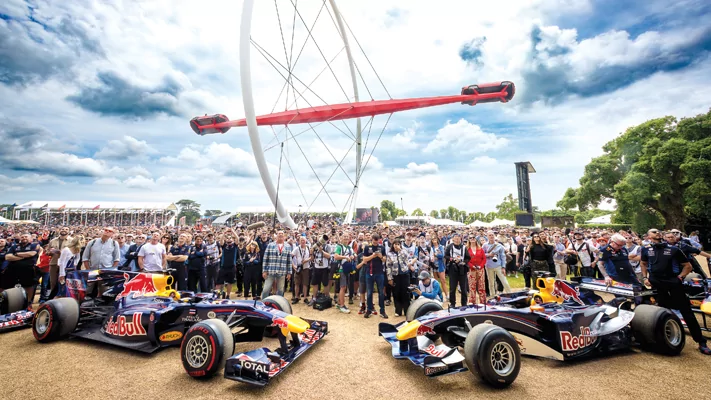Every summer, the quiet rolling hills of the South Downs and the Duke of Richmond’s expansive royal backyard echo with the roars of engines from the Goodwood Festival of Speed, one of the highlights of the international automotive calendar and an opportunity for different ends of the auto industry to smash into one another. Vintage cars putter past models that won’t be out until next year. Cheap cars park next to cars worth the price of a luxury house. And slow cars leaking trails of oil take to the same track as some of the fastest cars in the world.
Whether it’s the banging, unsteady rumble of V-12s from ages past or the high-pitched harpy whines of finely tuned F1 machines, peaceful gaps between the songs of internal combustion are few, far between, and unwelcome. Cacophony is the lifeblood of the annual festival, the U.K.’s biggest car show and a chance for automakers to show off achievements of the past alongside offerings of the near future. A mix of locals and car worshippers from across England’s mountains green gather to gawk at every conveyance from legendary winners of Le Mans to old bangers private craftsmen resurrected.
The one feature of the Goodwood Festival that sets itself apart from other major international car events like California’s Pebble Beach Concours d’Elegance is the Hillclimb. Never was there a more accurate and succinct description of a modest spectacle. A menagerie of vehicles ranging from century-old classics from automakers long since extinct to the latest electric models looking for buyers take a single run from Goodwood’s lush green pit row up a hill past an adoring public.

That’s it — but it’s more than you get at Pebble Beach and its ilk. Those stuffier, more elitist car shows park museum pieces and vanity builds out on a beautiful golf course that should be hosting foursomes that day instead, and unless you’re on the Pebble Beach Golf Links at sunrise when all of those cars arrive to take their places, you never see them move at all. You end up standing around in the hot sun and drinking an overpriced cocktail until some 1937 Duesenberg originally owned by the Red Skull takes home a trophy.
Goodwood is more vibrant and playful. There are certainly cars worthy of supervillains on display, but the crowds get to hear some decades-old cylinders bark and smell rubber shredded by burning out tires on an open-wheel rocket originally driven by Ayrton Senna or Niki Lauda. All of this noise and haste plays out against a Victorian portrait of English societal classes mingling. Well-heeled buyers for the most elite international makes do their pre-shopping, deciding how they’ll drop their next six figures. They pass by the sceptered isle’s everyman and his children as they eye those poster stars of little boys’ aspirational walls such as Ferrari and Koenigsegg.
Amid the mix this year, it feels like the world of automobiles is shifting away from the everyman and more into the lap of the folks who have everything. Ask Rolls-Royce. Goodwood plays out a ball bearing’s throw from that company’s immaculate factory and corporate headquarters. When asked about the festival’s ability to bring Joe Six Pack together with Country Club Reginald, Gerry Spahn (head of corporate communications for Rolls-Royce North America) kept the focus on the heavy hitters.
“Goodwood is the true home of Rolls-Royce, and we’re thrilled that it hosts this gathering of luxury lovers every summer,” Spahn said. “While we travel to places like Monaco, Pebble Beach, and Dubai regularly to celebrate with our clients, there’s nothing more intimate than sharing a few days with them on the spectacular Goodwood grounds.”
Those most British of car builders, Jaguar and Land Rover, arrived at Goodwood looking to the future. Once an all-purpose banger of an SUV that saw duty from the African bush to a Midlands farm, the Land Rover Defender is now a luxury performance creation. Its builders chose Goodwood to debut its new variant, the OCTA class — Defender’s 626 horsepower, ultimate off-road design that comes equipped with enough power and toughness to drove through the living rooms of those who can’t afford its $160,000 price tag.
Across the same pristine white tent, Jaguar is in the midst of a major transition, moving away from a full line of midrange luxury consumer cars to a handful of very high-end and all-electric rides. Fans and would-be buyers will have a better opportunity to see the end result of that evolution at next year’s festival. For now, Jaguar and its managing director, Rawdon Glover, made sure the automaker kissed the Goodwood ring.
“Anyone who experiences the festival will find everyone with the Goodwood staff has a passion for automotive,” Glover says. “They do everything brilliantly along the way to creating an event that is quintessentially British. As an exhibitor, it gives us access to 300,000 people, and those people are right for us.”
Still, is the car world Goodwood reveals right for all of “those people”? Beyond all of the star-studded hill climbs, the festival also serves as advertising. The majority of driving fans in attendance come to the Festival of Speed in the market for reliable, petrol-driven cars with approachable price tags. What they find is electrification creep with MSRPs heading north to match. The ham-and-egger, working folks end up with fewer options they can grasp.
To understand the shifting nature of Goodwood and the overall automotive industry, consider MG. The iconic British sports car builder created the two-seat MGB (or Midget, in less sensitive times), sold in its original form from 1963 to 1968. Until the Mazda MX-5 Miata came along to claim the title of bestselling roadster, the MGB rubbed European shoulders with the 1966 Alfa Romeo Spider as the most immediately recognizable and desirable two-seaters in gearhead history. Best of all for the ancestors of today’s Festival of Speed crowds, the MGB was priced to fit in reasonably-sized garages.
Celebrating its 100th anniversary in 2024, MG wanted to make a lot of fuss at this year’s festival to introduce a new line of vehicles ready to reintroduce the company to the marketplace. The star of the rollout is the sexy Cyberster — the good-looking, all-electric roadster descendant of the original MGB (with an unfortunate, overly corporate name that falls from the lips with an audible thud whenever spoken). Introduced with a fireworks display highlighted in the red, white, and blue of the Union Flag, the Cyberster sat high over the assembled masses, balanced on a massive sculpture across from its sister of the 1960s. A U.K. drum corps pounded out a patriotic beat as the nation’s car lovers came together in a proud throng remembering one of their historic native brands and looking forward to its very British resurrection.
CLICK HERE TO READ MORE FROM THE WASHINGTON EXAMINER
The only problem is MG is now entirely owned by the Chinese. All of its 21st-century cars will be built in China. Like the old British Mini now built by BMW in Germany, the Cyberster looks back to the era of Twiggy and Cliff Richard, while sending more than $54,000 per car to Xi Jinping and company. It seems British cars once celebrated at Goodwood for their appeal to lovers of everything motorized (while remaining within reach of a healthy portion of buyers) went electric and headed east.
As Defender achieves ultra-performance, Jaguar goes all-electric, and Rolls-Royce does Rolls-Royce, the legions who also stand and drool rightly admire the beautiful, advanced machines these companies build for their customers. Across the way, watching from the stands, there are plenty of onlookers at the Goodwood Festival of Speed who wish there was something new for them to play with, too.
John Scott Lewinski is a freelance reporter whose work has appeared in Forbes, Barron’s, and the BBC.























